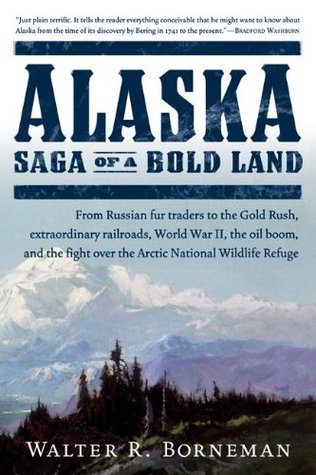More on this book
Kindle Notes & Highlights
The Mendenhall is one of thirty-eight glaciers flowing from the 1,500-square-mile (larger than Rhode Island) Juneau Icefield. In about twelve miles, the Mendenhall drops from an elevation of 4,500 feet at the icefield to 54 feet above sea level at its terminus at Mendenhall Lake. Ice formed at the glacier’s head takes about eighty years to make the journey. Less than 250 years ago, the glacier’s face stood 2.5 miles farther down the valley than its current position, and as recently as the 1930s, it still covered the rocks where the visitor center now stands.
These general dates coincide with the cold spell—if a “spell” can be said to last for millennia—of the Pleistocene Ice Age. The massive ice sheets that draped across the northern parts of North America and Asia locked up great quantities of the earth’s water. With so much water trapped as ice, the sea levels dropped at least 250 feet and perhaps as much as 350 feet below contemporary levels. Much of the world’s continental shelves were exposed, including a wide swath of land that in effect joined North America and Asia. Long called the Bering Land Bridge, this “bridge” was in fact over 1,000
...more
The following general terminology is both respectful and historically accurate. Alaska Natives collectively refers to the special status of the Native peoples of Alaska, whether they are of Inupiat Eskimo, Yup’ik Eskimo, Aleut, Alutiiq, Athabascan, Tlingit, Haida, or Tsimshian heritage. (A native Alaskan is anyone born in Alaska.) Eskimo has been used historically to group Alaska Natives throughout the Arctic coastal region, but it is more correct to identify the specific languages and cultures of Inupiat or Yup’ik.
it seems overly simplistic to say that there are four major cultural areas of Alaska Natives: Aleuts throughout the Aleutians; Inupiat and Yup’ik Eskimos along the Arctic coast; Athabascans in the interior; and the Tlingit and Haida of the southeast coast. But it is a place from which to begin.
Malaspina was an eighteenth-century “techie.” Not only did he consult the experts in Cadiz and Madrid for the latest in chronometers, sextants, and related navigational gear, but also he was well ahead of his time in understanding and implementing the food storage and preparation procedures necessary to maintaining healthy crews. Antiscorbutics to combat scurvy were a must, and he even experimented with distilling drinking water.
On November 6, 1865, the Shenandoah sailed into port there under the Stars and Bars and surrendered. In just over a year, she had circled the globe, covered some 58,000 miles, captured thirty-eight ships, sinking thirty-two and releasing six on bond, and taken more than 1,000 prisoners—all without taking or losing a life.
Alaska, the Aleut word meaning “a great country or land,” had originally been applied only to the Alaska Peninsula, first by the Russians and later by Captain Cook.
the New York Times, fired a shot across Greeley’s bow by declaring that “while narrow-minded political bigots have been exhausting all their resources in branding him [Seward] as a traitor to his party, he has been quietly pursuing great objects of permanent and paramount interest for his country.”
with, he relied on Russian documents expressing sovereignty over the Bering Sea and argued that the United States assumed this position upon its purchase. Barely into his case, however, he discovered that these documents were forgeries of the enigmatic Ivan Petroff, a Russian whose nefarious handiwork of historical half-truths and outright lies is spread throughout the history of Russian America.
One grizzled miner asked Toyatte why he and his men did not shoot plenty of ducks for the minister. “Because,” Toyatte replied, “the duck’s friend would not let us; when we want to shoot, Mr. Muir always shakes the canoe.”26
“Some ambitious young ensign on a surveying vessel, perhaps, stole my glacier, and later charts give it the name of Dawes. I have not found in the Alaskan statute books any penalty attached to the crime of stealing a glacier, but certainly it ought to be ranked as a felony of the first magnitude, the grandest of grand larcenies.”28
“With people wrangling and fighting over freight, with confusion, great avalanches booming down the mountain sides all about us, and absolutely no one able to give us anything but abuse, my first view of Dyea was accompanied by one long and two thousand short blasts of profanity.”26
If there is a fitting valedictory for the Harriman Alaska Expedition, perhaps it was the words penned by Henry Gannett in his section of the report on the general geography: “There is one word of advice and caution to be given to those intending to visit Alaska for pleasure, for sightseeing. If you are old, go by all means; but if you are young, wait. The scenery of Alaska is much grander than anything else of the kind in the world, and it is not well to dull one’s capacity for enjoyment by seeing the finest first.”36
Cape Nome had been noted on Russian charts as Mys Sredniy (Cape Middle) but seems to have gotten its English name when a draftsman in the British Admiralty took the query “? name” on a draft chart to mean “C. Nome” or Cape Nome. Strange, but apparently true.
“There are a thousand women in the district,” George Adams wrote, “and they have, as usual, taken vigorous action with the sanitary questions; brave, noble, energetic, self-sacrificing American women—God Bless them!—mothers, wives, daughters, sisters, and sweethearts who will urge upon those near and dear to them the pressing need of better sanitation.”42


